My journey deeper into the RepRap 3d printers is continuing at a pace. This is good as it is about 14 years since I “quite fancied getting one” but didn’t have a spare £200,000 and the company I worked for couldn’t quite see the point, which at the time was fair enough.
It was in 2006 when I nearly spent a few thousand on one, but bought Second Life islands instead.
Now it is all merging, as predicted. The 3d design of virtual worlds and the tools around those provide a great distribution mechanism for content to be printed. It’s not all completely straightforward but in this Maker Culture we only need a few bits that hook together to put a workable solution in place for most things.
After doing the 3d printing piece on Cool Stuff Collective I said to Malcolm Napier I was up for joining in his Thames Valley RepRap User Group (TVRRUG) as they were gathering a group of people to mass buy and tweak the RepRap Prusa model. The cost of this being well below any other way of doing this, in the hundreds. Whilst its a bit of a trek to go to the meetings (part of this is about socialising the tech) there are plenty of online ways to share. That of course is the point and where being a metaverse evangelist fits in.
I picked up the first parts of the kit from Malcolm last Friday. Then spent a few nights with spanners, youtube and a hammer putting together the first part of the kit. I am primarily a software person, mechanical engineering has never been my strong point, though electronics, soldering etc is or was. So I figured that if I applied myself and got the right tools, with the support of TVRRUG I would be able to make this work.
So it started as a cardboard box of bits. The main structural pieces are metal rods, joints, angles and moving parts have been printed on a reprap (which is the point of the design to self replicate)
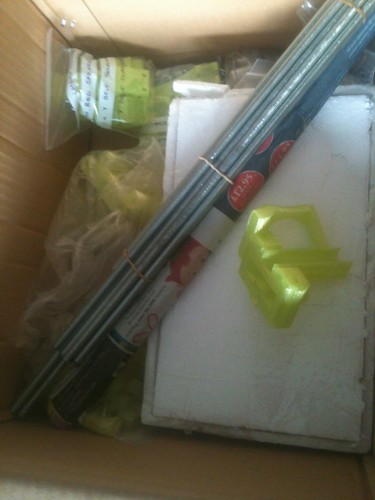
Its gives you a bit of a oh heck where do I start moment as you unbox.
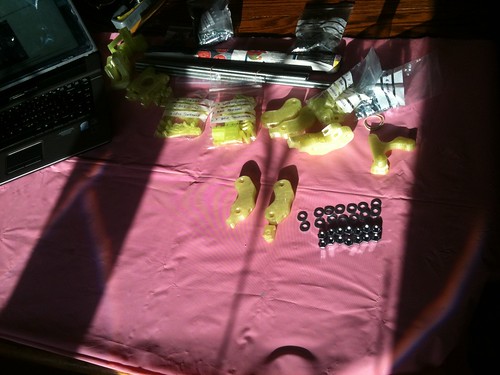
However, the prusa video explanations get you going very quickly. The fixed camera position and clear audio really helps. There is text to read and fall back to but I found the audio and visual worked just fine.
Once the first parts went together…. we were away
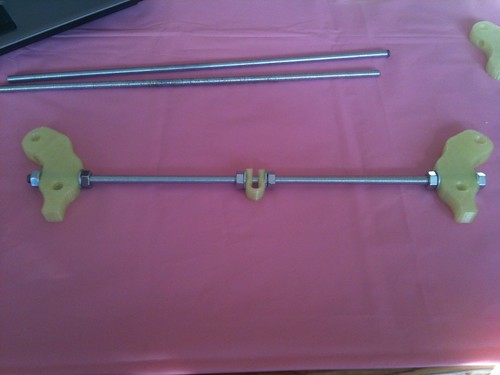
The end triangular structure soon took shape
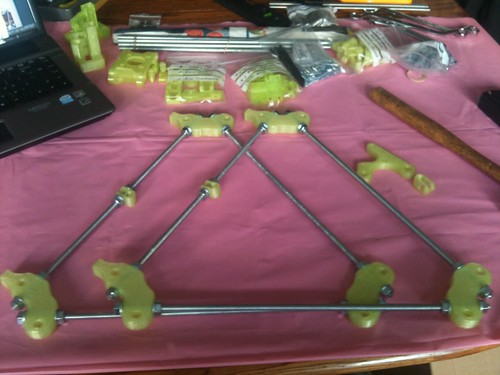
Bearings and motor holders attached to cross beams, washers all over the place
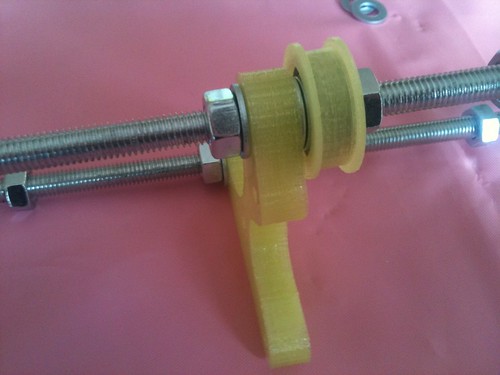
Next the frame started to take its tentative steps to standing upright.
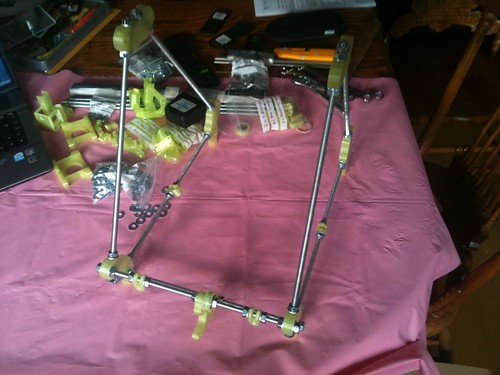
By this stage I realised (and was also being told by the instructions) that getting the measurements correct and squaring off the frame was very important.

It is around this time my software mind thinks… we can get the basics going and revisit performance and tweak it later, but instead an engineering mind thought, for once, no! get the tools measure it properly with verniers callipers and make this thing work as close as possible, and keep revisiting this as bits are added.
(There are two types of good software developer. The precise engineer who builds exactly to spec, very much needed skill and the other sort that builds for flexibility, using the spec as a guideline. Both skills complement one another and you have to know when to do each. I am not suggesting software is a giant bodge, though in many case it may well be)
Having got the frame it was then very exciting to put on the plywood moving platform which has tube bearings. It is here that using tool to make it as accurate as possible (i.e. not a quick look with a tape measure) seems to have paid off. I did have to have a couple of goes and strip this bit down but now have a relatively smooth running platform.

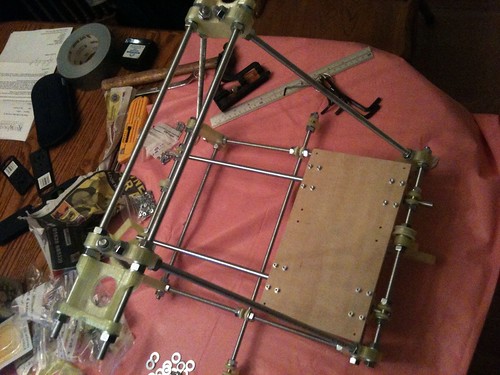
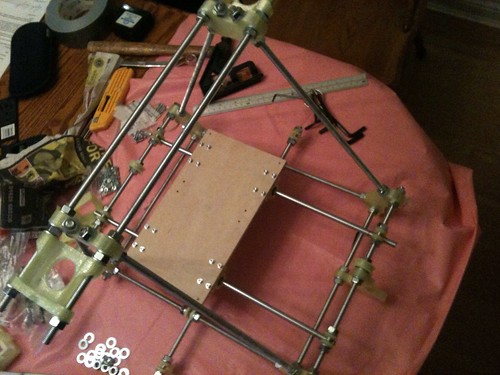
By this time I was on the specific instructions by TVRRUG as we have a slightly wider machine and some parts have been modified, which is the nature of all open source development including mechanical ones.
Last night was the final pieces of this bit of jigsaw with the vertical drive stepper motors the the rods that that lift up and down
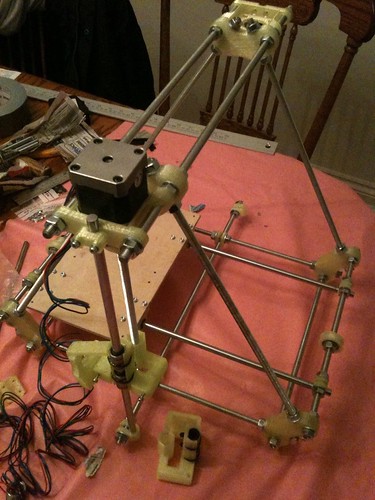
There was a tiny bit of adjustment needed again to make sure things were squared off and equal as putting the final rods for the x axis showed there was a millimetre or so of pushing needed to get the last screw in place. However I think the care in the early stages paid off. I may still have to get more accurate but it feels right, looks right and doesn’t wobble 🙂

So there is it, ready and waiting for the user groups next batch of pieces. Having built one to this stage it would make building another considerably easier.
As with all these things it is good to doing things, to be hands on and not just talk about them. Of course there is a way to go yet but I hope in the not too distant future I can start exploring some of the ways we get things to print. After all I have the haptic device, virtual worlds, minecraft etc all generating the right content.
So I will become a fully fledged fabricaneur. Making things as a business.
Whilst on the subject of 3d printing I also popped along to the Aram Gallery 110 Drury lane. A furniture shop that has a 3d printing exhibition running for a few weeks on its 3rd floor. This is called Send to Print / Print to Send
It had all sorts of examples of 3d printing. It was interesting hearing the comments of some of the other visitors as they tried to figure out the impact of all this. I tried not to dive into the conversations and enthuse at them 🙂
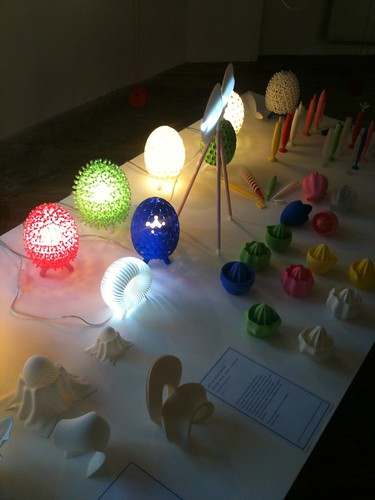


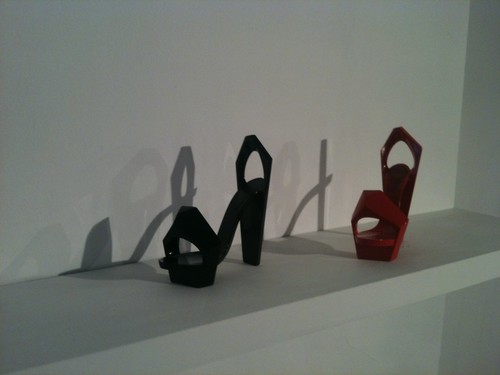
The full set of pictures is here
I was really pleased to see the examples of solar sintering there form the self contained desert machine by Markus Kayser

His video of this experimental art form was going down rather well earlier in the year.
The gallery was showing a number of videos including this one of the work.
They also had a fully completed reprap there, a slightly different model to mine but great to see one close up again and take the time to look at it, with a more experience eye onto its construction.

reprap
Cool Stuff Collective RepRap 3D printing
Today The 3d printing (part ii) aired on The Cool Stuff Collective. A huge shout out of thanks goes to Malcolm Napier and his daughter Hannah (who has built most of the machinery) for bringing along their collection of RepRap 3d printers and getting it all working so well so quickly. Including the dicussions on which colour plastic we should use for the best impact. (Blue in this case 🙂 )
Also thankyou to @AndyPiper for the intro’s via Reading Geek Night. A particular unsung hero award to producer Ros who manages to make all the arrangements and get things to make these items work.
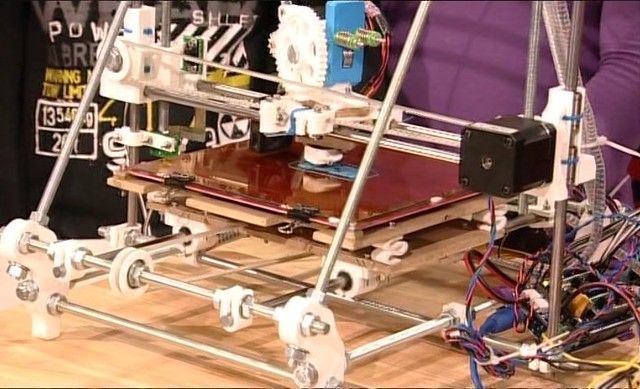
The kids at the school we filmed at were enthralled as were the Archie productions crew, with the printer actually working. That is always a good sign when you are going to be showing some future tech.
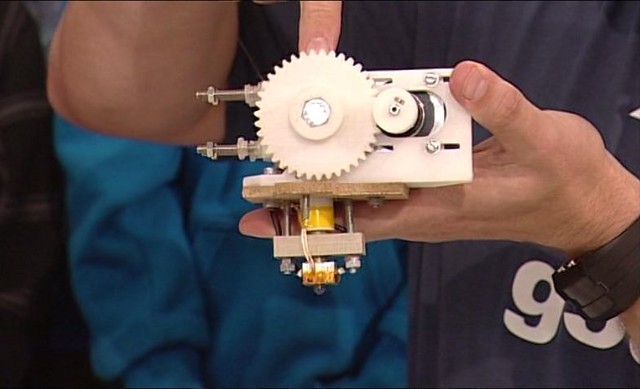
In the piece we talked about how the printer worked, how the reprap is designed as an open source project that aims to replicate one printer from another. I also threw in the massive change to manufacturing and the planet of replicating what you need locally. No packaging, shipping, wasted manufacture. It’s a huge concept, but the kids watching the show will be living in a world where that is even more important.
We also talked a bit about bio printing, though I did point out thats not with a reprap (yet!). Vicky brought in the kids questions, which were all their own too. One in particular about why is this different from a lathe was great 🙂
Now a set of reprap bits costs about £300, so I think that every school should be making one in science lessons and then learning about how to craft 3d objects.
The kids loved the g33k tokens. it was almost the start of a new craze 🙂
Malcolm and Hannah created the g33k text 3d model, whilst we had lots of taller bigger samples we could print it was better to have a relatively thin but constantly repeating model to not cause massive continuity errors or problems for when they get edited up by series producer Jenny. If you can imagine printing a tall tower some takes, and doing 2 takes of the piece and trying to weave the best parts of each together. With my ad hoc non scripted presentation it would mean the tower would keep changing height. We also did not want to keep stopping and starting the reprap. Though it would cope it was better to just film whilst it was running.
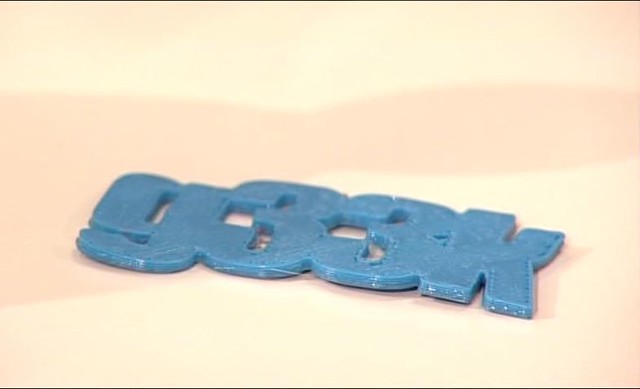
If you are in the UK and you want to see the show it is on the ITV player for the rest of the week.
I would love the show to be out there for a wider audience as I am really happy with what we have been doing the past few series and it feels it is getting better all the time.
If it can help and inspire just a few people back into science, or open up some creative maker talent out there then I think we are doing a good job.
It seems an age away from that first show, and my “debut” as a boffin in the luvvie world (to quote google’s boss Schmidt). Yet it was only a year ago, but over 30 shows of future tech already in the can(or memory stick)!
Roll on monday/tuesdays recordings!
RepRap – Open Source 3d Printing – Changing Society
I realised that whilst I talk about RepRap a lot to people and have blogged elsewhere about it this blog has no good reference to RepRap. So here it is.
In putting a shout out for help and ideas on 3d printing for the cool stuff collective RepRap keeps getting mentioned by people. It is an intriguing project and has the sort of spirit and goals that I really relate too.
RepRap is an opensource hardware and software project to build a 3d printer, one of whose aims is to be able to print and replicate the parts to make another RepRap printer.
RepRap from Adrian Bowyer on Vimeo.
The video above is from Adrian Bowyer the inventor of RepRap, it has some great points about replicating nature with insects and flowers, plus you can see how a printer works.
To people who have not yet Grokked the whole massive impact this micro/local manufacture will have there is something very primeval about explaining the self replication by a piece of hardware, that seems to sit well with us humans.
I am fairly convinced that saying this machine is able to make the parts for itself is one of the most obvious examples of a use case. It is also both a joke, threat and obvious at the same time.
I often talk about the redistribution of manufacturing and the cultural impact it will have, but increasingly I am also talking about the feedback loop that occurs when those things manufactured are placed into our lives and then by their very existence alter the things that occur around us and to us.
Think about how the remote control on the TV altered our homes and the way we used television. It took a few years for everyone to upgrade to a TV with a remote, but they are pretty ubiquitous now. Imagine how quickly an innovation such as that would infect/enhance our homes and lives if we could print them out as they happened.
The spread of the end product in this way would also lead to even quicker open source projects based on whatever this device or object was, projects to take that and use it in even more advanced ways, sharing the information along the way.
This can be a cycle in fashion accelerated not to seasons and production runs but to right now, to changes in architecture, to sudden new character collectible toys and games.
You do not have to ponder this very long to add together the power of sharing across the web and willingness to self organise with an open source mentality combined with not just software or ideas but with physical items and you can see that there is an even greater cultural shift, and its way more than people say hi to one another on Twitter and Facebook.
It really is very exciting and scary at the same time.
The open source approach and mentality is really a giant feedback loop with adjustments and mutations made along the way like a genetic algorithm. Throw atoms, not just virtual digits and the proposition expands a great deal.
